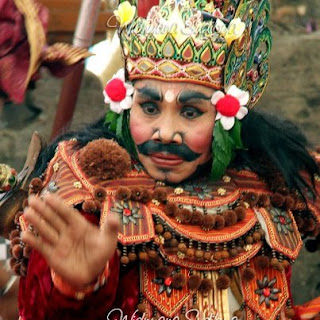In
Bali, exactly, we know a lot about the culture that we have inherited from our
ancestors. Starting from the way of life in villages by developing traditional
farming
systems, traditional woodworking tools as it has dimuseumkan Kerta Gosa in
Klungkung in the form of plowing tools (read: tengalan), and many others. Well
that caught my attention is the traditional dance that accompanies a custom
event / ceremonies such as Dance Jangkang of Pelilit - Nusa Penida, Dance
Gambuh of Br. Watas Tanglad Village - Nusa Penida.
Little consultation with local residents, gambuh dance usually performed at the time of Galungan in order to accompany a series of ceremonies at Galungan is but it is also used as the local people perform weddings, but it is also much sought / invited by neighboring villages in order to accompany yadnya ceremony also, the local people call it nunas Tirta Gambuh. On the day of Galungan, Gambuh dance is staged in the afternoon / evening H. Character - a character in the dance Gambuh pretty much as well. Originally Gambuh dance begins with two dancers perform with cast of "Lean and Galuh" usually called Lean are usually played by 2 men - men chosen by the respective manners. The language used-rada rada resemble Kuna Kawi language, such as "lahya Kakang in Semar, Ange supervisor Pedandangin su.!" (Might be wrong on the spelling), and so on. After the figure is complete Lean and Galuh staged, followed by Dance Gambuh real. Type character played roughly about 10 types of figures. The story takes an historical sector in the kingdom era of Kuna. One side of the figure, took the figure of a king who was given the title Panji sweet, and as figures bersebrangannya / antagonist was named Raden Prabangsa / King Hardware. These two figures followed by Parekannya like Uncle Megatik, Wijil, and penasar. Parekan figures as these may be more joke at their first dance on the stage, but at their Kings come, dikerajaanpun atmosphere like at present.
Long story short, the two leaders fought contest king then drew his dagger magic with them, and pertunjukanpun finished with ending "the Kings are still in a state of fight". I was there minds that gambuh dance was finished / finished the story., but after a time, reappearing a more sinister figure, played by two people wearing masks "Prisoner" Local people call it. The other fashion figures like Hanuman with all-white outfit with his trademark white-tailed. Then figure another with a higher posture, dressed in bright red, known as People Ditya, similar to the character of Ravana. After investigate investigated, it turned out fight between the Kings earlier (and Raden Panji Prabangsa) transmitted to the rate of change in the form of a higher (Hanuman and Ditya) which is sesuunan local communities. The fight ensued fierce high level, causing some spectators took part in it because it is not strong with the atmosphere that occurs in the dance, the locals call Nadi / Kerauhan caused by the atmosphere of both the high-level figures, the atmosphere had become hysterical. In the middle of the fight, a figure suddenly appeared Bhagawan character played by local people in villages are usually played by local Stakeholders. With an all-white outfit, the Bhagawanpun gave a lecture to the two men who fought earlier.

0 comments:
Post a Comment